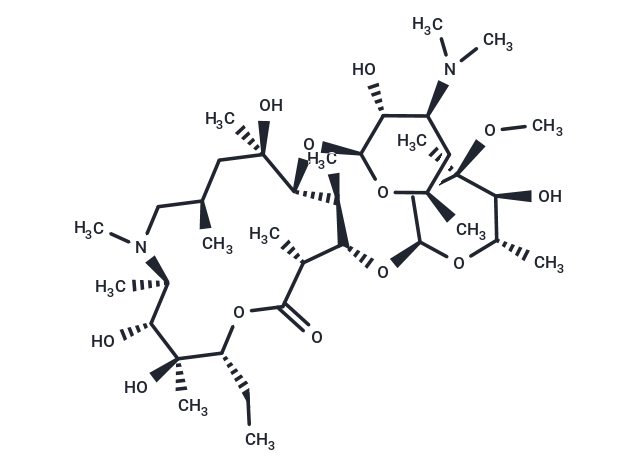Shopping Cart
- Remove All
 Your shopping cart is currently empty
Your shopping cart is currently empty

Azithromycin (CP 62993) is an antibiotic by inhibiting protein synthesis, used for the treatment of bacterial infections.

| Pack Size | Price | Availability | Quantity |
|---|---|---|---|
| 50 mg | $56 | In Stock | |
| 100 mg | $84 | In Stock | |
| 500 mg | $219 | In Stock | |
| 1 mL x 10 mM (in DMSO) | $62 | In Stock |
| Description | Azithromycin (CP 62993) is an antibiotic by inhibiting protein synthesis, used for the treatment of bacterial infections. |
| In vitro | Azithromycin reduces about 40% of IL-8 mRNA and protein expression in cystic fibrosis (CF) cells reaching the levels of non-CF cells. Azithromycin results in 50% and 70% reduction of NF-kappaB and AP-1 DNA binding, respectively, leading to levels of non-CF cells. Azithromycin significantly enhances the intensity of a co-stimulatory molecule, CD80, on DCs but not CD86 and CD40 in dendritic cells (DCs). Azithromycin significantly increases the production of IL-10 and Clarithromycin (CAM) significantly inhibits the production of IL-6 by DCs. Azithromycin increases IL-10 and CAM decreases IL-2 productions significantly, when naive T cells derived from spleen are co-cultured with DCs treated in advance with LPS and these macrolides.Azithromycin selectively inhibits fluid-phase endocytosis of horseradish peroxidase and lucifer yellow in J774 mouse macrophages. Azithromycin delays sequestration of receptor-bound transferrin and peroxidase-anti-peroxidase immune complexes into cell-surface endocytic pits and vesicles. Azithromycin down-regulates cell surface transferrin receptors, but not Fc gamma receptors, by causing a major delay in the accessibility of internalized transferrin receptors to the recycling route, without slowing down subsequent efflux, resulting in redistribution of the surface pool to an intracellular pool.Azithromycin inserts into the DOPC lipid bilayer, so as to decrease its cohesion and to facilitate the merging of DPPC into the DOPC fluid matrix. |
| Cell Research | THP-1 cells (106 cells in 1 mL RPMI medium, without antibiotics, growth factors or serum) are seeded in each well of 24-well plates and allowed to settle for 1 hour. Next, 50 μL of the test compound is added followed by 50 μL of LPS (final concentration of 10 μg/mL). After 24h (37°C and 5% CO2) the supernatants and cell pellets are collected (1200 rpm, 5 min). THP-1 cell viability is tested using 3-(4,5-dimethylthiazol-2-yl)-2,5-diphenyltetrazolium bromide (MTT). MTT is dissolved at 2 mg/mL in PBS and aliquots are stored at -20°C. The MTT assay is performed according to the suppliers instructions. Absorbance of MTT converted into formazan is measured at a wavelength of 570 nm with background subtraction at 630 nm. |
| Alias | Zithromax, XZ-450, CP 62993 |
| Molecular Weight | 748.98 |
| Formula | C38H72N2O12 |
| Cas No. | 83905-01-5 |
| Smiles | O([C@@H]1[C@@H](C)[C@H](O[C@H]2C[C@](OC)(C)[C@@H](O)[C@H](C)O2)[C@@H](C)C(=O)O[C@H](CC)[C@@](C)(O)[C@H](O)[C@@H](C)N(C)C[C@H](C)C[C@@]1(C)O)[C@H]3[C@H](O)[C@@H](N(C)C)C[C@@H](C)O3 |
| Relative Density. | 1.18 g/cm3 (Predicted) |
| Storage | Powder: -20°C for 3 years | In solvent: -80°C for 1 year | Shipping with blue ice. | ||||||||||||||||||||||||||||||||||||||||
| Solubility Information | DMSO: 18.33 mg/mL (24.47 mM), Sonication is recommended. Ethanol: 74.9 mg/mL (100 mM), Sonication is recommended. | ||||||||||||||||||||||||||||||||||||||||
Solution Preparation Table | |||||||||||||||||||||||||||||||||||||||||
DMSO/Ethanol
Ethanol
| |||||||||||||||||||||||||||||||||||||||||

Copyright © 2015-2025 TargetMol Chemicals Inc. All Rights Reserved.